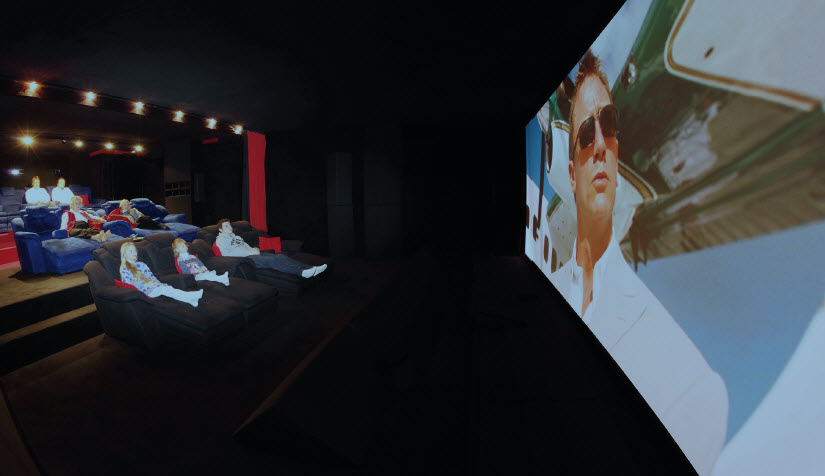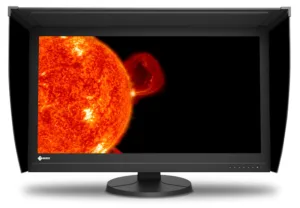I was recently at the ProLight & Sound Show in Frankfurt and saw that a significant topic was the use of ‘black’ LEDs and it made me think about black in displays. Those outside the industry often think that the challenge in making good displays is making a bright white, but, more often the challenge is making a really good black.

The reason that black is so important is that it’s usually contrast that gives the ‘wow’ impact of really good displays and that is the ratio between the bright and dark parts of the image. For example, if you have a TV with 500 cd/m² when it’s bright, and has, let’s say, an IPS LCD panel, the contrast ratio is going to be around 1,000:1. That would mean that the black areas of the screen will have an output level of 0.5 cd/m² and the LCD is blocking 99.9% of the light from the backlight. Usually, this kind of number is measured with the display in a dark room… often a very dark room. That’s because the black level depends not only on the light that is generated by the display, but is also affected by any ambient light that hits the screen and is reflected. Add another 0.5 cd/m² from the room and the measured contrast would go down to 500:1.
One way to maximise the contrast is to eliminate the reflections, either by having a very highly sophisticated system to eliminate the reflections or to avoid them in the first place. The second option is the one that’s usually adopted in the test situation.
Projection is Particularly Sensitive
Reflections are particularly an issue in projection systems, where the screen tends to be optimised to reflect light to keep the highlights bright so it’s prone to picking up any ambient light. RealD has done some very interesting work that was released at the Display Summit before Infocomm in 2015, when it explained that the limit for contrast is set by light from emergency lighting, but also light shining from the cinema screen, onto the faces of the viewers and then reflected back onto the screen. As much as 0.3 to 0.7 cd/m² can be produced on the screen just from reflections from the seating, when part of a screen is bright. That makes it pointless to chase huge contrast numbers for the projector alone – above 10,000:1 to 20:000:1, the overall system contrast doesn’t go up by very much.
I recently had an interesting chat with a really dedicated home cinema enthusiast, Wolfgang Mayer, who has optimised his screening room to give as high contrast as possible. As he said, using black surfaces around the room doesn’t look very attractive, but it does allow him to achieve high levels of contrast. Of course, the colours can also look more saturated where they are undiluted by ambient light.
 Wolfgang Mayer’s Home cinema has black walls
Wolfgang Mayer’s Home cinema has black walls
Black is Also Tough for Direct Displays
Direct displays also have this problem. In the past, one of the disadvantages of phosphor-based displays such as CRTs and PDPs was that the light emitting phosphor materials were relatively reflective. That meant that they looked much better in dark conditions – I have a PDP as my main TV and I still prefer to watch with the lighting turned off at the end of the room where the display is. OLEDs and LCDs don’t have such issues. One of the reasons that LCD beat PDP in TV sales was simply that in a bright retail environment, the black performance of LCDs could look better than on the PDPs.
The challenge for LCDs is not from reflection, but from light leakage. If there is any mis-alignment of the liquid crystals, it’s hard to block the light from the backlight. That’s one of the reasons that VA LCD panels have higher contrast than IPS – the molecules are more homogenous over the whole of the pixel area than on IPS. With OLEDs, if you don’t want light, you just turn off the pixel and you get a true black. The challenge for OLED displays is to get higher brightness with peak luminance (and then when only part of the display is lit) at around 700 – 800 cd/m².
Eizo Fixes Contrast/Brightness Challenge
At NAB this week, Japanese monitor maker, Eizo is showing a new monitor that will be available next year, that combines the high brightness of LCD at 1,000 cd/m², with a claimed 1,000,000:1 contrast ratio. One way to get this kind of highlight specification number is to simply turn off part of the backlight where you want black, but unless you have an LED for every pixel, that means ‘halos’ around the bright points that you want. So how has Eizo done this?
We couldn’t get confirmation, but we believe that the company is using a dual modulation system, with a second monochrome LCD between the backlight and the main LCD that controls the amount of light coming out of the backlight. In that configuration, you can get a ‘multiplication’ effect between the contrast of the two LCDs, so if you have 1,000:1 on the backlight and 1,000:1 on the main panel, overall you can get 1,000,000:1.
A similar concept was shown a few years ago by Sharp as a technology demo and Christie has used the idea of a second modulator to create a projector with extreme contrast. However, I think this is the first time I’ve seen this concept in a (close to) production monitor. It won’t be cheap, but it’s an interesting development. (BR) (I plan to return to this topic with a deeper look at the issue of black in LEDs)
Eizo’ CG3145 has 1,000,000:1 contrast

